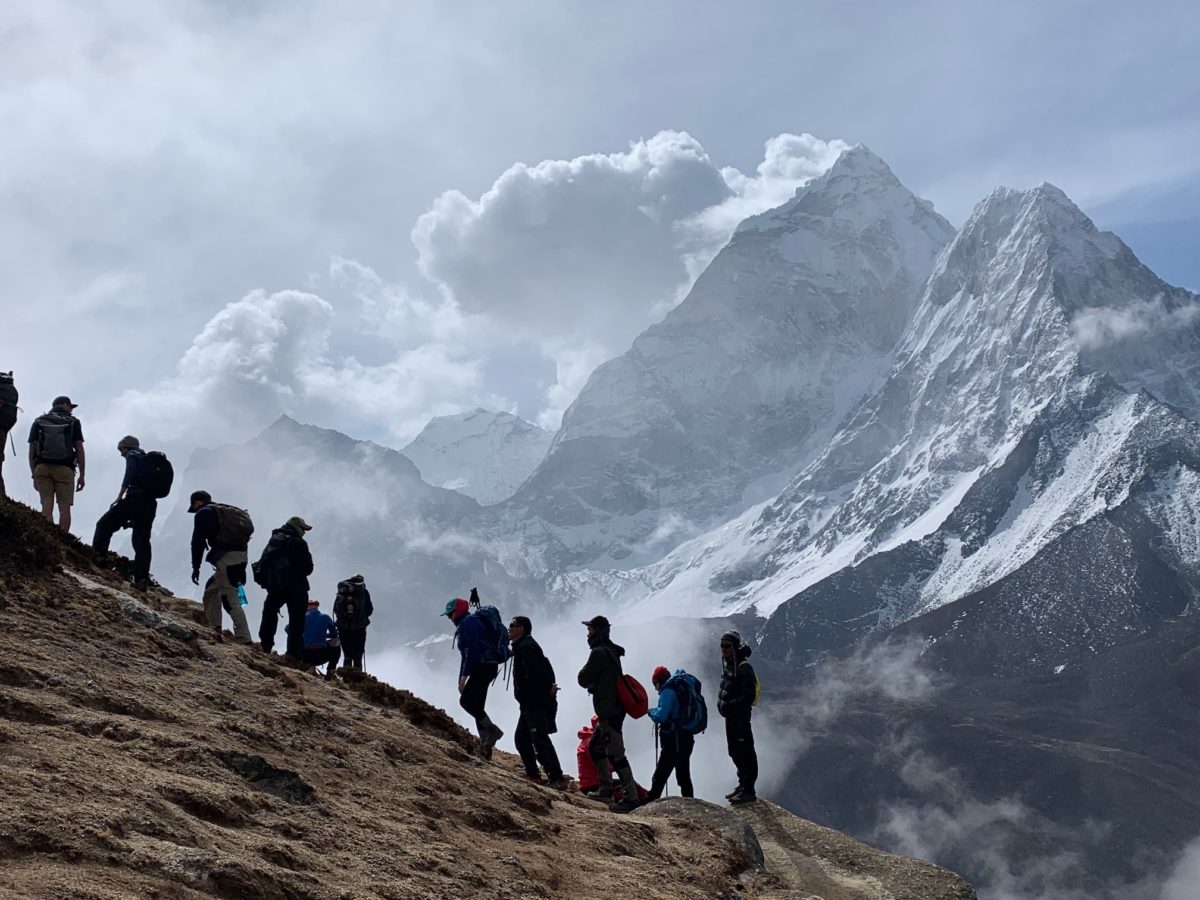Consider packing your bags for the next climbing season, immersing yourself in the beauty of the Himalayan country. Ensure you seek answers to vital questions about the climb, particularly, “How long does it take to climb Mount Everest?”
Before launching on your Everest Base Camp journey, thorough research on climbing Mt. Everest is crucial—especially understanding how long it takes. Climbing Everest demands time.
The trek includes a two-week hike to Everest base camp at 17,000 feet. Subsequent weeks involve altitude adjustment, weather waiting, and a four-day climb to the summit.
Table of Contents
History of Mount Everest—and how old is it?
Mount Everest, known as Sagarmatha in Nepali and Chomolungma in Tibetan, spans Nepal and Tibet in the Himalayan mountain chain. The mountain is close to the equator, sharing a latitude with Tampa, Florida.
Geologically, Everest is a youthful 50 to 60 million years old, shaped by the collision of the Indian and Eurasian tectonic plates. This constant force elevates Everest’s summit, increasing its height by about a quarter of an inch annually.
How long does it take to climb Mount Everest?
The overall journey spans 43 days, with 26 core climbing days. Understanding the duration for how long does it take to climb Mount Everest is crucial, whether 43 days or 26 core days, is crucial for trip planning.

The ascent is not a walk in the park, mainly due to reduced oxygen levels at high altitudes, intensifying the breathing struggle. The ability to use fixed ropes, ice axes, and crampons becomes crucial for this adventure.
At an elevation of about 5300 meters, the Everest Base Camp precedes the Khumbu icefall climb, requiring 4-5 days for acclimatization. Climbing to Camp 1 and spending two nights, then returning to Base Camp marks the acclimatizing process. This pattern repeats, accelerating the ascent. The acclimatization phase, essential yet time-consuming, involves rest stops at various camps to conserve energy.
This way you came to know about the North Ridge route, characterized by a challenging rocky path, which adds a technical dimension to the expedition and how long does it take to climb Mount Everest.
Explore The Climb one by one
Launching on Everest starts in lively Kathmandu, Nepal, where climbers tackle administrative tasks and gather gear for their journey. This phase, about a week long, is essential.
Trekking to Base Camp spans 9-12 days, departing from Lukla, Nepal. The arduous trek weaves through picturesque landscapes and traditional villages, aiding climbers in gradual altitude adaptation.
Acclimatization, a 3-4-week phase at Everest Base Camp, involves climbs to nearby peaks to adjust to thin air, reducing altitude-related risks.
Establishing camps and fixing routes is a 2-3-week process. Camps provide rest, while Sherpas navigate treacherous terrain, ensuring safer passages. Sherpas, known for their rich culture and climbing skills, are vital guides.
The Summit Push, a 12-20-hour final ascent from Camp 4, signifies the Everest peak.
Scaling Everest takes 7-9 weeks, demanding careful planning, rigorous training, and respect for nature’s forces. Everest, with over 200 frozen bodies, requires adequate preparation and group collaboration for survival.
Difficulties to Climb Mount Everest
Altitude Sickness: The primary risk for Everest climbers, affecting health due to decreased oxygen at higher altitudes. Your body can adapt, but limitations exist beyond 8,000m.
Temperature: Everest’s air temperature drops by about 0.65C per 100 meters, reaching frigid levels. Adequate preparation for extreme cold is vital to avoid illness during the climb.
Falls: Falling is the leading cause of death on Everest, occurring on high ridges or in moments of carelessness at camps. Care in footwork, knot checking, and experience on snow and ice reduce this risk.
Crevasses: Crevasses, cracks in glacial ice, pose risks to climbers. Found in Khumbu Ice Falls and Western Cwm, teams secure members with ropes to help safe glacier traversal, ensuring rescue in case of falls.
Tips to Climb Mount Everest

- Ensure a gradual pace during walks; don’t hurry to reach your destination. Walking slowly is crucial for trek completion.
- Determining the prime time for Everest climbs depends on unpredictable weather. The summit’s temperature, averaging -36 degrees Celsius in January, drops to -60 degrees.
- Optimal climbing periods are spring (April to May) and autumn (September to October), offering clear visibility and moderate weather.
- Prioritize non-alcoholic fluid intake; alcohol dehydrates the body, impacting your trek.
- Prepare physically before Mount Everest climb; engage in activities like running, swimming, and cycling three weeks before.
- Guard against altitude sickness by carrying Diamox tablets and staying well-hydrated.
- Pack rain gear for monsoon treks and always bring suitable trekking gear.
When is the best time to climb Everest?
Most climbers aim for Everest in May due to favorable weather. Acclimatization, adapting to high altitudes, extends the climb duration.
In Nepal, the South Base Camp sits at 17,598ft (5,364m), while the Tibetan North Base Camp is at 16,900ft (5,150m). Many live well below the moderate elevation range (5000-8000ft, 1524-2438m), finding 11,000ft–14,000ft (3352-4267m) challenging. Climbers avoid rain for safety, seeking the highest chance of summiting.
How much does it cost?
It’s anywhere between $35,000 to over $100,000, covering essentials like the $11,000 climbing permit, bottled oxygen, high-altitude gear, medical care, food, and support from Sherpa guides.
For the Everest Base Camp trek, a key segment of the expedition, about 10 days are spent trekking from Lukla to the base camp, repeating the route after the descent. This trek, lasting 43 days in total, is a popular Nepal adventure. It provides an opportunity to approach Everest closely without scaling its peak. The primary charm lies in Everest Base Camp.
Beyond Everest Base Camp, numerous attractions pepper the journey. Tengboche Monastery, a significant Buddhist site, and Kala Patthar, a crucial viewpoint offering outstanding mountain views, are amazing. Namche Bazaar, the bustling town with diverse facilities and a distinctive atmosphere, adds a touch of home away from home.
Mount Everest Route Map

Your Everest Guide, a constant companion on treks and expeditions, is a seasoned professional with comprehensive knowledge. They navigate the challenges, making your journey less arduous, and will let you know how long does it take to climb Mount Everest making it more enjoyable. In tough times, your guide offers motivation, often proving sufficient to keep you going. Whether trekking or embarking on an expedition, having an Everest Guide is indispensable for a successful journey.
How many routes are there to the top?
17 routes explore Everest’s summit, yet most climbers choose one of two. Nepal offers the Southeast Ridge, pioneered by Tenzing Norgay and Edmund Hilary in 1953. Tibet presents the North Ridge, where George Mallory vanished in 1924, conquered by a Chinese team in 1960.
Experienced mountaineers find the routes comparably challenging but distinct. The Southeast Ridge demands a sprint through the difficult Khumbu Icefall. Despite a shorter summit day, emergencies allow for quicker descents. The North Ridge allows jeep access to base camp but requires traversing kilometers above 27,000 feet to reach the summit.
Conclusion
Climbing Mt. Everest demands serious commitment, extreme guidance, and thorough training. Combining mountain challenges and bodily changes, the answer to “How long does it take to climb Mount Everest? ” varies. The two-month journey, including base camp trek, acclimation, and 5-6 days for the final push, requires high fitness. Dedicating ample time to adapt to the extreme environment enhances well-being and performance. Choosing the right training plan with sufficient lead time is crucial given Everest’s climb duration.



